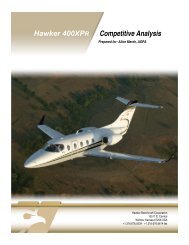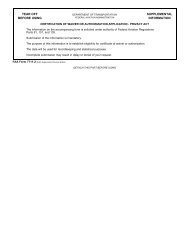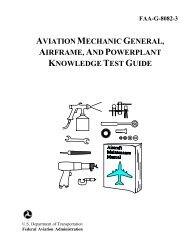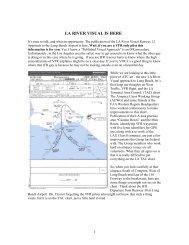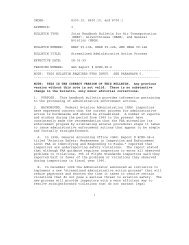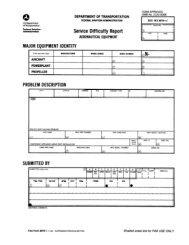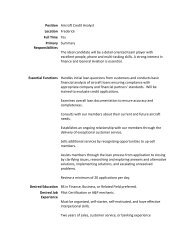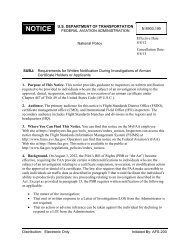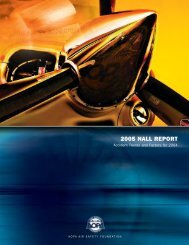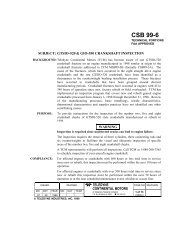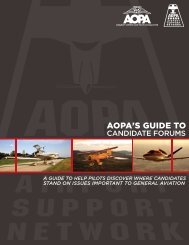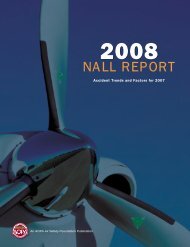Joseph T. Nall Report - Aircraft Owners and Pilots Association
Joseph T. Nall Report - Aircraft Owners and Pilots Association
Joseph T. Nall Report - Aircraft Owners and Pilots Association
Create successful ePaper yourself
Turn your PDF publications into a flip-book with our unique Google optimized e-Paper software.
Accident<br />
F<br />
Factors<br />
A T A L<br />
VFR in IMC<br />
Lost Control<br />
IFR in IMC<br />
Severe Weather<br />
Percent<br />
15<br />
12<br />
9<br />
6<br />
3<br />
0<br />
3.0%<br />
Fatal Weather Accidents<br />
0.0% (0)<br />
37.5% (3)<br />
0.0% (0)<br />
0.0% (0)<br />
0.0% (0)<br />
50.0% (3)<br />
Fixed<br />
Retractable<br />
Multi<br />
0 20 40 60 80 100<br />
Percent<br />
1996<br />
13.1%<br />
Accidents/<br />
100,000 Hours<br />
8<br />
7.47<br />
7<br />
6<br />
5<br />
4<br />
3<br />
2<br />
VFR Into IMC Accidents<br />
2.6%<br />
1997<br />
11.5%<br />
2.8%<br />
1998<br />
11.4%<br />
Weather/Light Conditions<br />
3.56<br />
4.80<br />
2.30<br />
2.1%<br />
5.18<br />
1999<br />
100% (13)<br />
62.5% (5)<br />
50.0% (3)<br />
Total Accidents<br />
Fatal Accidents<br />
9.4%<br />
3.80<br />
Total 6.89<br />
Total Accidents<br />
Fatal Accidents<br />
WEATHER<br />
36 TOTAL/27 FATAL<br />
Some accidents attributed to other causes<br />
involved weather as a contributing factor, as in the<br />
case of improper IFR approach, which was responsible<br />
for 13 fatal approach accidents. Wind shear<br />
<strong>and</strong> crosswinds also caused weather-related accidents<br />
in VFR conditions.<br />
Twenty-one of the 27 fatal weather-related accidents<br />
(77.8 percent) were caused by “attempted<br />
VFR flight into IMC.” Thirteen of these were in single-engine<br />
fixed-gear aircraft, accounting for all of<br />
the fatal weather-related accidents in those aircraft.<br />
Five of eight (62.5 percent) fatal weather-related<br />
accidents in retractable-gear single-engine airplanes<br />
were due to this cause. Three of the six fatal<br />
accidents in multiengine airplanes were also due to<br />
VFR into IMC. While many of these accidents<br />
involved inexperienced noninstrument-rated<br />
pilots, high-time commercial <strong>and</strong> airline transport<br />
pilots were also included. At least two flights<br />
involved professional pilots attempting VFR operations<br />
in weather that included ceilings of less than one hundred<br />
feet. VFR flight into IMC continued to be one<br />
of the most frequent single causes of fatal accidents,<br />
leading one to the question, “What is it about<br />
the fact that they can no longer see the ground that<br />
pilots don’t underst<strong>and</strong>?” Because so many of these<br />
accidents were fatal, there are few surviving pilots to<br />
answer the question. The AOPAAir Safety<br />
Foundation has published the Safety Review: General<br />
Aviation Weather Accidents, which offers detail <strong>and</strong><br />
analysis of weather accidents.<br />
In past years the relative magnitude of day to night<br />
fatal accidents doesn’t change much. However, night<br />
visual meteorological conditions (VMC) tends to be<br />
slightly higher than day VMC once the final tallies are<br />
complete. The key points are that both IMC <strong>and</strong> night<br />
substantially increase risk, <strong>and</strong>, when combined, lead<br />
to the most challenging flight conditions of all.<br />
1<br />
0.87<br />
0 .79<br />
Fatal 0.98<br />
0<br />
Day VMC<br />
Night VMC<br />
Day IMC<br />
Night IMC<br />
20



